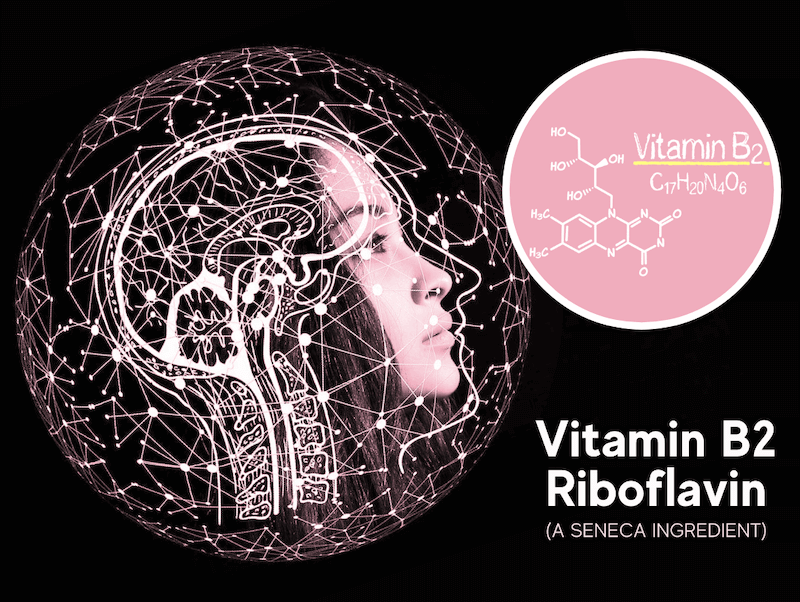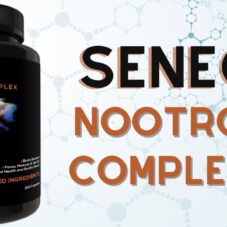In today’s article, we will discuss Riboflavin, aka Vitamin B2. It’s a water-soluble vitamin that is naturally present in many foods, including enriched food products. So, why did we add this ingredient to our Seneca Nootropic stack? Does this B vitamin have cognitive-enhancing benefits? Scroll down to find out!
Table of Contents
What is Vitamin B2 and what is it good for?
Initially isolated from milk, Riboflavin aka vitamin B2, is a member of the B complex vitamins. Its discovery came after Thiamine aka vitamin B1. All of the B complex vitamins have important roles to play in body functions, such as cell metabolism, energy production, and red blood cell synthesis (1).
So, according to the European Food Safety Authority, riboflavin contributes to energy-yielding metabolism, nervous system function, healthy red blood cells, and normal mucous membranes. It also helps with normal skin and vision, reduces tiredness and fatigue, and protects cells from oxidative stress.
Additionally, there is some evidence pointing to Riboflavin’s preventive effects on cataract development, lowering of homocysteine levels, and reduction in the frequency of migraine attacks (2, 3).
Vitamin B2 sources: Where can you find Riboflavin?
You can find vitamin B2 in plenty of food sources, such as (4):
- Milk, eggs, oatmeal, yogurt
- Mushrooms, broccoli, spinach, almonds
- Organ meat
- Fortified cereals and fortified grain products
If you can’t get B2 from food, you’ll also find it readily available in supplement form. In fact, most brands of multivitamins include the complete lineup of B complex vitamins.
With that said, our Seneca Nootropic Complex is another excellent source of Riboflavin. More specifically, each serving of Seneca contains 1.3mg of B2 (this is equivalent to 100% of the recommended daily value) in Riboflavin-5-Phosphate form.
Related article: What are nootropics?
Why do we use the form Riboflavin-5-Phosphate in Seneca?
Riboflavin-5-Phosphate aka Flavin Mononucleotide (FMN) is the active form of Vitamin B2. It’s a more bioavailable form than Riboflavin, which is the inactive form.
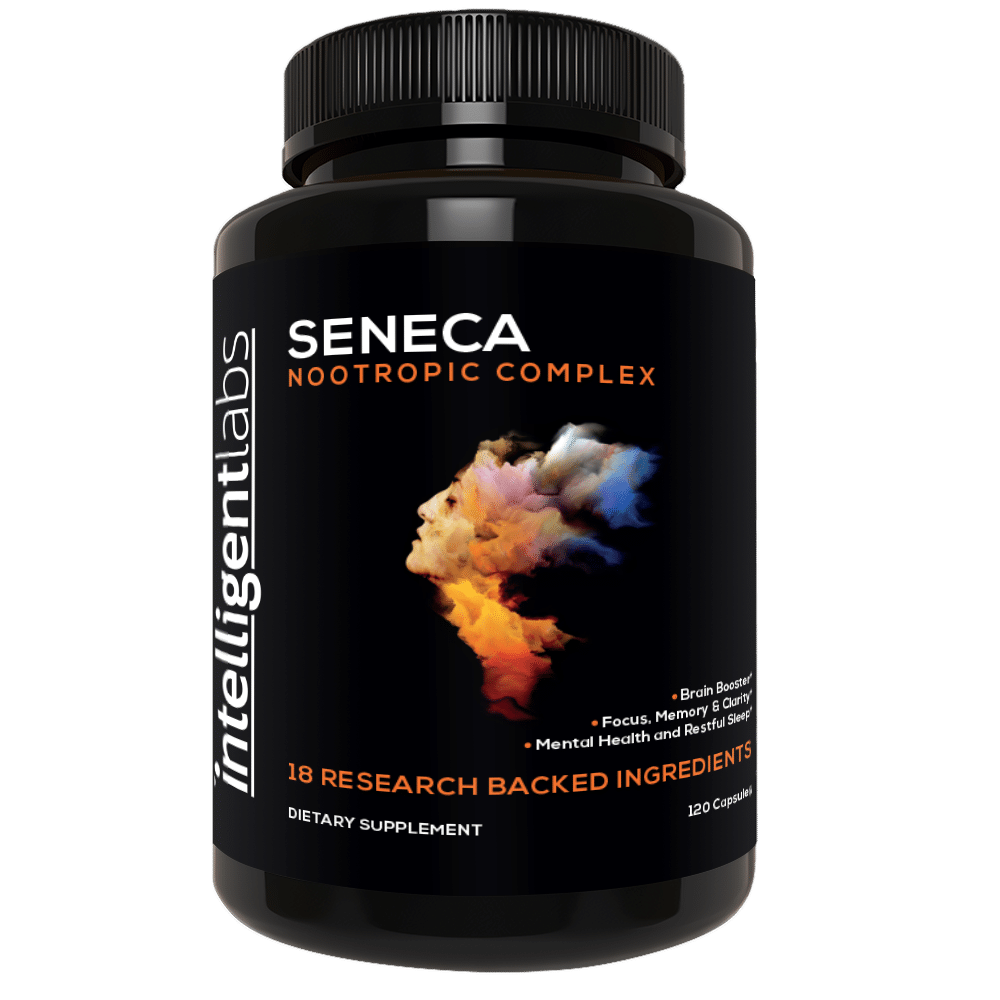
As you’ve learned in the previous section, Riboflavin is an incredibly important vitamin that participates in many biological functions. But for this article, however, we’ll focus on the main Riboflavin-5-Phosphate benefits that made us choose this particular form for Seneca. These are (5):
- Energy production
- Antioxidant defense
- Helps produce the active forms of Folate (B9), Vitamin B6, and Vitamin B3
We’ll cover these benefits more closely in the next section.
How does Riboflavin function in the body?
Here are some of B2’s most important functions that influenced our decision to add B2 (specifically in Riboflavin-5-Phosphate form) to Seneca:
Function #1 – Energy Production
Riboflavin-5-Phosphate or FMN itself is part of Complex 1 in the electron transport chain (ETC).
The electron transport chain is the most important part of energy production, where ATP is finally made in significant amounts. The chain itself is made of 4 major complexes. To put it differently, think of it like a little game of ‘hot potatoes’. So, the electrons are passed down the chain to a place where they can be safely combined with oxygen and antioxidants to produce carbon dioxide and water.
The electron transport chain occurs in the mitochondria’s inner membrane, our cells’ powerhouses. In complex 1, FMN takes an electron from NADH. It then passes it on to an iron-sulfur cluster, which then passes it on to CoQ10.
Complex 2 of the chain also uses B2 in the form of flavin adenine dinucleotide (or FADH2), another active form of B2.
FADH2 is produced in the Krebs or Citric Acid Cycle. This is the preceding part of the energy production cycle to the electron transport chain (which also occurs in the mitochondria).
Moreover, B2 is also a cofactor for pyruvate dehydrogenase complex and α-Ketoglutarate dehydrogenase complex. These two enzymes go in the Krebs cycle along with vitamins B1, B3, B5, and lipoic acid (5).
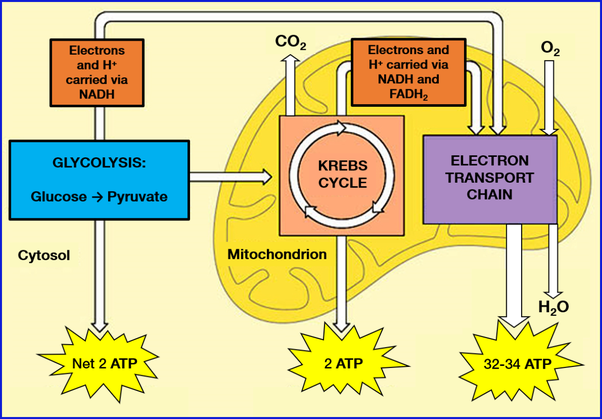
Function #2 – Antioxidant Function
Riboflavin is a cofactor for the enzyme glutathione reductase. Glutathione is considered the master antioxidant in the human body (6). However, once it donates its electron to quench free radicals, glutathione itself becomes oxidized.
Glutathione reductase catalyzes the reaction, which takes an electron from NADPH, and gives it to glutathione to reduce it again so that it can continue its function as an antioxidant.
The body also needs to keep a ratio of about 90% reduced glutathione to 10% glutathione. Reduced glutathione is ready to antioxidize (reduction means gaining an electron). On the other hand, oxidized glutathione means losing an electron. So, glutathione reductase is very important for antioxidant function.
In the example below, glutathione with the enzyme glutathione peroxidase (which also needs selenium) turns hydrogen peroxide into water. Hydrogen peroxide, aka household bleach, is one of the main oxidants found in the human body. It is produced during energy production and is also used by the immune system to kill invaders.
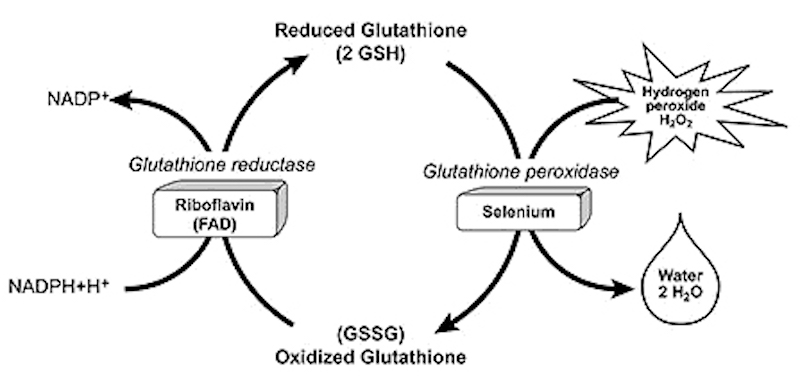
However, riboflavin is not just vital for glutathione production.
It helps recycle the antioxidant thioredoxin as a cofactor for the enzyme thioredoxin reductase.
Additionally, the enzyme NADH peroxidase also uses riboflavin to convert hydrogen peroxide and NADH into NAD+ and water.
This is in a similar way as glutathione turns hydrogen peroxide into water. But since so much hydrogen peroxide is used, we need more than one antioxidant to deal with it.
Function #3 – Active Vitamin Production
Research shows that B2 also helps with active vitamin production, specifically vitamins B3, B6, and B9 Folate (5).
For instance, B2 is needed to produce vitamin B3 through a biochemical pathway known as the kynurenine pathway.
It’s also needed for the PNPO enzyme. In particular, PNPO converts the inactive form of B6 (Pyridoxine) into the active form of B6 (P5P).
Vitamin B2 is also needed for the MTHFR enzyme in the Folate cycle. It produces 5-MTHF, which is used to turn homocysteine back into methionine.
Riboflavin deficiency symptoms
Riboflavin deficiency is rare in developed countries. But it’s a different story in developing countries, especially in Africa and Asia. Also, some groups of people have a greater risk of falling deficient in B2. This includes vegans, alcoholics, older people, and women who take birth control pills.
However, deficiency doesn’t happen overnight. After several months of inadequate B2 intake, the following signs of deficiency start showing up (7):
- Sores at corner of mouth
- Lesions and inflammation of lips
- Inflammation of tongue and oral cavity
- Anemia
- Neuropathy
- Seborrheic dermatitis
What’s the right dosage for Riboflavin?
Following these average daily recommended amounts may help prevent any of the riboflavin deficiency symptoms listed above:
| Age | Male | Female |
| 0 to 6 months | 0.3mg | 0.3mg |
| Infants (7-12 months) | 0.4mg | 0.4mg |
| Children (1-3 years) | 0.5mg | 0.5mg |
| Children (4-8 years) | 0.6mg | 0.6mg |
| Children (9-13 years) | 0.9mg | 0.9mg |
| Teenager (14-18 years) | 1.3mg | 1.0mg |
| Adults | 1.3mg | 1.1mg |
| Pregnant teens and women | n/a | 1.4mg |
| Breastfeeding teens and women | n/a | 1.6mg |
Can you overdose on Riboflavin?
Fortunately, the answer is no. Since B2 is water-soluble, any excess amount the body doesn’t need is flushed out via urine. There is also no upper intake limit for B2.
Conclusion
To sum up, riboflavin is a readily available nutrient found in many food sources and supplements. It’s a natural antioxidant with energy-boosting properties. Moreover, it contributes to active vitamin production, too. So make sure you meet B2’s recommended daily allowance (see table above).
References
(1) Vitamin B2 (Riboflavin), from Mount Sinai, https://www.mountsinai.org/health-library/supplement/vitamin-b2-riboflavin
(2) Riboflavin, from MedlinePlus, https://medlineplus.gov/druginfo/natural/957.html
(3) Supplementation with Riboflavin (Vitamin B2) for Migraine Prophylaxis in Adults and Children: A Review. Namazi N, Heshmati J, Tarighat-Esfanjani A, 01 Jan 2015, 85(1-2):79-87
(4) Riboflavin, from National Institutes of Health, https://ods.od.nih.gov/factsheets/Riboflavin-HealthProfessional/
(5) Riboflavin in Human Health: A Review of Current Evidences, Ahmad Saedisomeolia, Marziyeh Ashoori, Adv Food Nutr Res . 2018;83:57-81.
(6) The changing faces of glutathione, a cellular protagonist, Alfonso Pompella, Athanase Visvikis, Aldo Paolicchi, Vincenzo De Tata, Alessandro F Casini, Biochem Pharmacol . 2003 Oct 15;66(8):1499-503.
(7) Riboflavin Deficiency Navid Mahabadi; Aakriti Bhusal; Stephen W. Banks, StatPearls [Internet].

